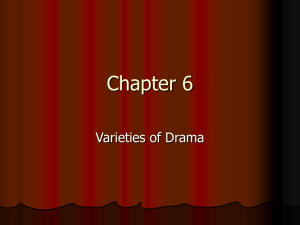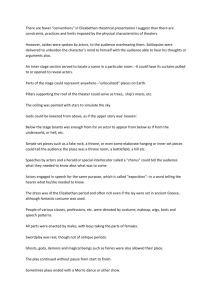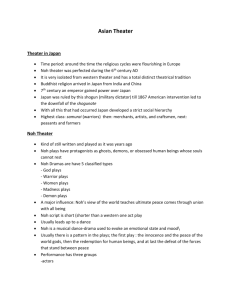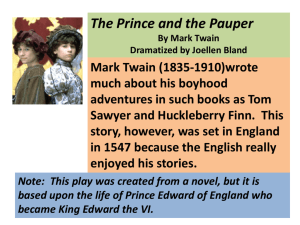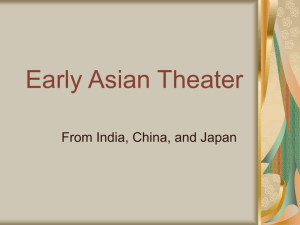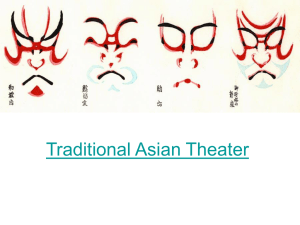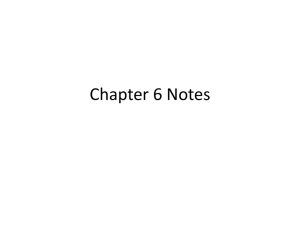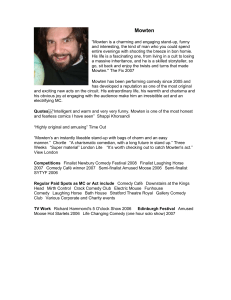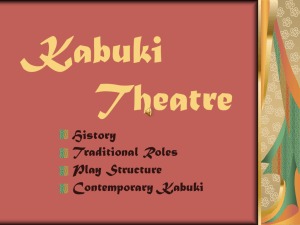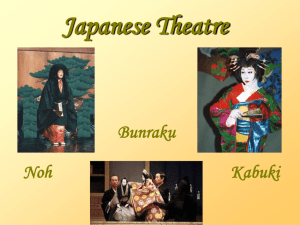Style Book - WordPress.com
advertisement
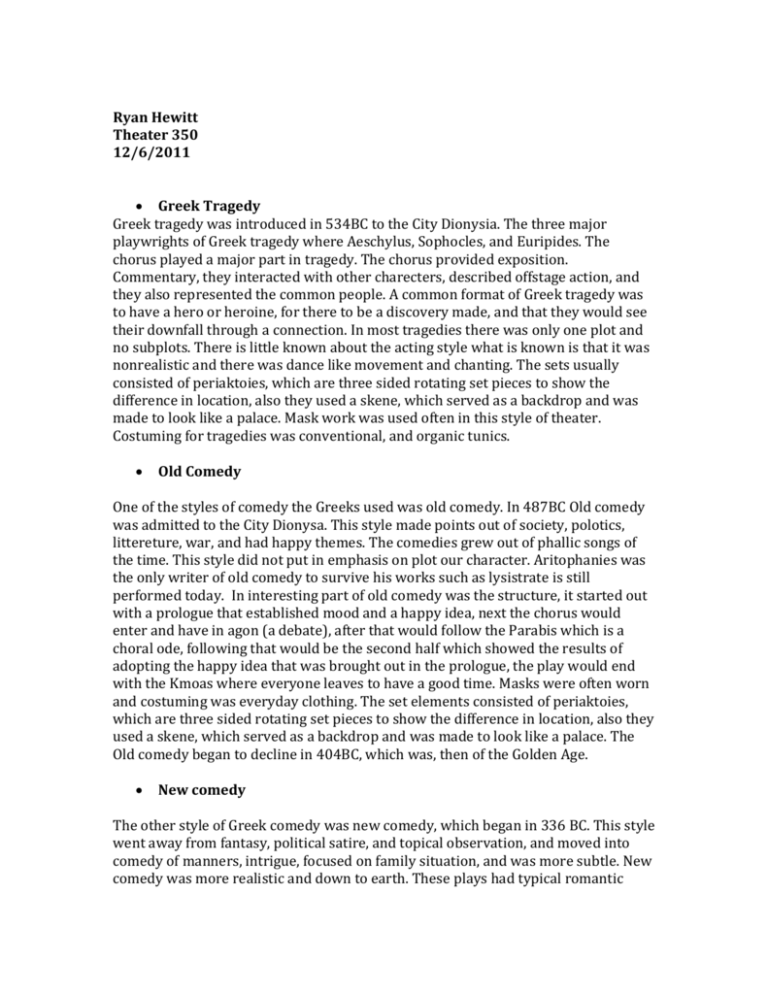
Ryan Hewitt Theater 350 12/6/2011 Greek Tragedy Greek tragedy was introduced in 534BC to the City Dionysia. The three major playwrights of Greek tragedy where Aeschylus, Sophocles, and Euripides. The chorus played a major part in tragedy. The chorus provided exposition. Commentary, they interacted with other charecters, described offstage action, and they also represented the common people. A common format of Greek tragedy was to have a hero or heroine, for there to be a discovery made, and that they would see their downfall through a connection. In most tragedies there was only one plot and no subplots. There is little known about the acting style what is known is that it was nonrealistic and there was dance like movement and chanting. The sets usually consisted of periaktoies, which are three sided rotating set pieces to show the difference in location, also they used a skene, which served as a backdrop and was made to look like a palace. Mask work was used often in this style of theater. Costuming for tragedies was conventional, and organic tunics. Old Comedy One of the styles of comedy the Greeks used was old comedy. In 487BC Old comedy was admitted to the City Dionysa. This style made points out of society, polotics, littereture, war, and had happy themes. The comedies grew out of phallic songs of the time. This style did not put in emphasis on plot our character. Aritophanies was the only writer of old comedy to survive his works such as lysistrate is still performed today. In interesting part of old comedy was the structure, it started out with a prologue that established mood and a happy idea, next the chorus would enter and have in agon (a debate), after that would follow the Parabis which is a choral ode, following that would be the second half which showed the results of adopting the happy idea that was brought out in the prologue, the play would end with the Kmoas where everyone leaves to have a good time. Masks were often worn and costuming was everyday clothing. The set elements consisted of periaktoies, which are three sided rotating set pieces to show the difference in location, also they used a skene, which served as a backdrop and was made to look like a palace. The Old comedy began to decline in 404BC, which was, then of the Golden Age. New comedy The other style of Greek comedy was new comedy, which began in 336 BC. This style went away from fantasy, political satire, and topical observation, and moved into comedy of manners, intrigue, focused on family situation, and was more subtle. New comedy was more realistic and down to earth. These plays had typical romantic plots and recognizable stock type characters such as domenering parents, romantic lovers, and comic servants. New comedies are usually written in five acts. The chorus is used to sing, and dance and serve as in interlude between acts. Menander is the only playwright of this time whose work still exists today but only in parts, his only complete work is Dyskolos (The Grouch). Mask was often worn and costuming was everyday clothing. The set elements consisted of periaktoies, which are three sided rotating set pieces to show the difference in location, also they used a skene, which served as a backdrop and was made to look like a palace. Morality Play Morality plays are attempts to teach a moral lesson by using allegorical characters. These characters usually are going on a journey usually about a battle of good vs. evil. Morality plays use the same staging as most cycle plays. Shakespearean Shakespeare wrote comedy, tragedy, history and problem plays. His plays where written in episodic form and he perfected iambic which was shown in his plays. Shakespearean theater had on stage violence, subplots, and revenge as a motif. Shakespearean plays where produced on raised platforms on thrust stages with a center tap door. The type of scenery used was spoken scenery because location changed quickly there was also very minor props used. Costumes where not usually historically accurate and where mostly contemporary Elizabethan style. The acting style for these shows was not realism men also played women and actors where typically double or even triple cast. The actors would improve parts and barely ever-new there lines because there was such a small rehearsal period. Noh The style of Noh was brought out in the 14C and featured roving troupes. The writing of this style was not normal storytelling they where musical dance dramas that embodied emotions. The actors in these productions where trained from childhood. The characters types in these productions where a chorus of ten, Kamimono which praised the gods, Shuramono which where warriors, Kazuramono which where women, Kuruimono which where Mad persons and spirits, and Kirinomono which where Demons, devils, and supernatural beings. The stage had no scenery but would have Hashigakari, which is a Bridge that is 20’ish long. Also the stage would have a Butai, which is the main space, and it is in 18-foot square, which is covered with four columns. The supporting actors would use the Hurry door’s to enter and exit. The back of the theater had a ceremonial pine tree painted on it. Costumes for this style where very elaborate and also featured mask. Noh acting style used dance and pantomime each movement and vocal tone followed very set rules, which is why performers had to start training so early. Bunraku Bunraku was brought about during the Tokugawa period at a time when the wealthy supported Noh. The merchants wanted something different for entertainment so Bunraku was started primarily in Osaka. This style used puppets which where two-thirds of a life size person and needed three operators to work one controlled the legs, one the left arm, and one the right arm and head. The person who controlled the right arm and head was dressed elaborately. On the stage the puppeteers sit and stand behind railings. The stage was three levels and used elevators and traps to lower and raise scenery as the script called for. Kabuki In 1603 Okuni of Izumo a female dancer created the style of Kabuki. In 1616 there where seven theaters in Kyoto. Early Kabuki Theater was based around dance and was very romantic and erotic. To start with it was mainly women but in 1629 women kabuki was banned because it was too sexual the same thing happened in 1652 with boys’ kabuki. Kabuki had many influences from Bunraku instead of using puppets the actors mimicked the puppets movement and the plays where adapted from puppet shows. Actors where trained in vocal dexterity, dancing, acting, and physical versatility. Male actors also had to learn Onnagata, which is how to imitate women. In kabuki the actors do not sing the narrarator is the one who sings. The actors combined speaking and dance and begin training at 6, they begin with dance then diction, intonation, and finish off with wearing the costumes. These costumes weighed up to fifty pounds and they had to have stagehands help them walk in them. Costumers did not worry about historical context but each role had a specific traditional costume. Scenery for kabuki featured a decorated stage. Every place the actors visited was shown on stage. The back of the stage had flats to show distance. The stage featured a wide and low proscenium, the musicians where located on or off stage, the stage had elevator traps on it and usually revolved. An interesting thing in Kabuki Theater is the Hanamichi which where used for entrances and exits.
